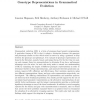169 search results - page 28 / 34 » Fine-Grained Timing Using Genetic Programming |
CEC
2009
IEEE
14 years 4 months ago
2009
IEEE
—In this paper we discuss the notion of situated evolution. Our treatment includes positioning situated evolution on the map of evolutionary processes in terms of time- and space...
ASC
2010
13 years 10 months ago
2010
Grammatical evolution (GE) is a form of grammar-based genetic programming. A particular feature of GE is that it adopts a distinction between the genotype and phenotype similar to...
CP
2003
Springer
14 years 3 months ago
2003
Springer
Multiple sequence alignment is a central problem in Bioinformatics. A known integer programming approach is to apply branch-and-cut to exponentially large graph-theoretic models. T...
BMCBI
2007
13 years 9 months ago
2007
Background: Molecular biologists need sophisticated analytical tools which often demand extensive computational resources. While finding, installing, and using these tools can be ...
GECCO
1999
Springer
14 years 2 months ago
1999
Springer
Genetic programming makes it possible to automatically search the space of possible programs. First we evolved a behavior-based control architecture using computer simulations. Th...



